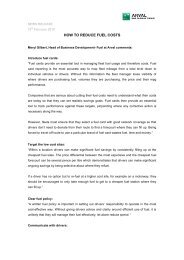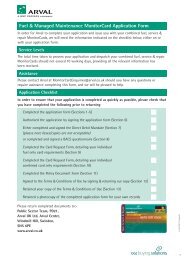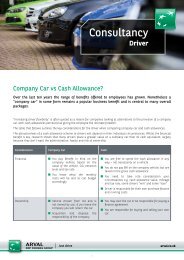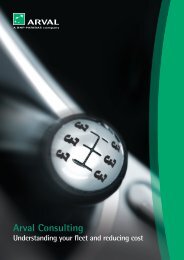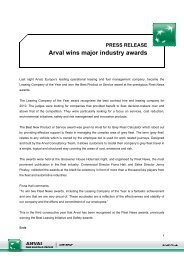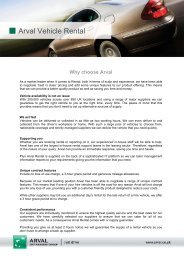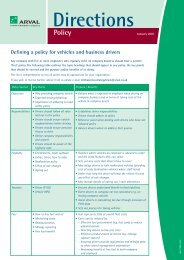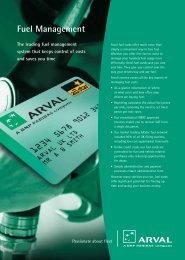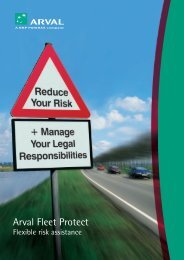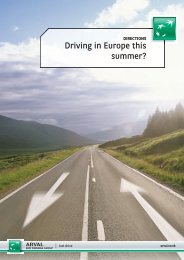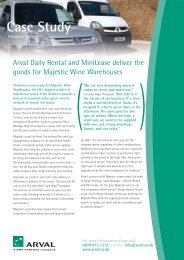You also want an ePaper? Increase the reach of your titles
YUMPU automatically turns print PDFs into web optimized ePapers that Google loves.
<strong>Reducing</strong> <strong>your</strong><br />
Fleet’s <strong>C02</strong><br />
The <strong>Arval</strong> fuel card Driving Training www.arval.co.uk<br />
Tips and advice<br />
What is the<br />
current situation?<br />
Driver behaviour<br />
Vehicle choice<br />
Efficient maintenance<br />
Journey planning<br />
Alternative fuels and<br />
vehicle technology<br />
Drivers top 10<br />
tips poster
What is the current situation?<br />
Global warming is said to be the greatest challenge of the 21st century.<br />
With a quarter of UK carbon emissions emanating from road transport, fleets<br />
are at the forefront of efforts to drive down CO2.<br />
This message was underlined by the Budget in<br />
March 2008. Alongside new carbon-based tax<br />
measures designed to raise more than £2<br />
billion from vehicle users, the Treasury<br />
published a major report on the future for<br />
low carbon cars – the King Review.<br />
If formally adopted by the Government, the King Review is expected to become the roadmap for<br />
cutting CO2 emissions from passenger cars by an ambitious 30% in the next five to ten years. It<br />
urges the Government to create a framework in which low carbon vehicle technologies can go<br />
from ‘shelf to showroom’ as quickly as possible and where fiscal incentives and public education<br />
create a ready market for new, low emission products.<br />
Currently, the Government’s policy is to ‘encourage the polluter to pay.' Drivers can expect rising<br />
BIK taxes on greenhouse gases and higher operating costs for environmentally inefficient vehicles,<br />
for example higher congestion charges and VED. For businesses that reduce their carbon footprint<br />
there will be opportunities to take advantage of tax breaks, as well as a lower fuel bill!<br />
For example, a fleet of 200 drivers, averaging 15,000 business miles per year produces over 700<br />
tonnes of CO2 during a year. If the fleet reduced its annual emissions by 20%, through measures<br />
such as mileage reduction and buying lower-emission vehicles, it could save over 140 tonnes of<br />
CO2 (and around £60,000 in fuel purchases).<br />
How do I know what my fleet's current CO2 is?<br />
Wanting to reduce <strong>your</strong> fleet’s carbon footprint is one thing, but knowing what it currently is, is<br />
essential. Fuel cards are a powerful tool in this respect, they enable fleet operators to capture and<br />
analyse data on CO2 emissions, worked out on the actual fuel consumption of every vehicle, and<br />
the fleet as a whole. This gives companies a starting point, and from this, plans and targets can<br />
be set and monitored over time.<br />
What can I do to reduce my fleet's carbon footprint?<br />
There are a number of ways to reduce carbon emissions, mainly surrounding vehicle choice,<br />
maintenance, driver behaviour and the journey taken.<br />
By looking at each area in detail it will allow you not only to reduce CO2 but to enjoy additional<br />
business benefits - such as a reduction in repairs, wear and tear costs, an improved driver risk<br />
rating and a lower fuel bill.<br />
Find out more about:<br />
The <strong>Arval</strong> fuel card Driving Training www.arval.co.uk<br />
Tips and advice<br />
What is the<br />
current situation?<br />
Driver behaviour<br />
Vehicle choice<br />
Efficient maintenance<br />
Journey planning<br />
Alternative fuels and<br />
vehicle technology<br />
Drivers top 10<br />
tips poster<br />
To find out more detail on<br />
how you can reduce <strong>C02</strong> click<br />
on the links above.
What can my drivers do to reduce their <strong>C02</strong><br />
footprint?<br />
Your drivers play a very large role in determining <strong>your</strong> fleets' CO2 emissions.<br />
They do this through the way they drive; their attitudes and expectations;<br />
and the cars they choose.<br />
Let drivers know that reducing CO2 is an important goal for <strong>your</strong> business, and that they are<br />
expected to drive efficiently and avoid making unnecessary journeys. Include statements to this<br />
effect in the fleet policy and driver handbook.<br />
Drivers must start to realise the link between fuel consumption and <strong>C02</strong>,<br />
it is therefore essential for them to understand and act on the following points:<br />
Check <strong>your</strong> revs – Change up between 2000 – 2500 rpm. Revving <strong>your</strong> vehicle’s engine wastes fuel; Avoid<br />
fast getaways at the traffic lights – accelerate slowly when the light turns green. The faster you accelerate<br />
the more fuel you will consume. Avoid revving <strong>your</strong> engine before you turn it off.<br />
Anticipate road conditions and drive smoothly – Avoiding sharp acceleration and heavy braking. This saves<br />
fuel, tyre wear and reduces accident rates. Drive smoothly – aggressive driving increases fuel consumption and<br />
produces more CO2. Avoid accelerating or braking too hard – this can reduce fuel consumption by more than<br />
10% in urban areas.<br />
Use air conditioning sparingly – As it significantly increases fuel consumption.<br />
Drive away immediately when starting from cold – Idling to heat the engine wastes fuel and causes rapid<br />
engine wear. Turn the engine off when you’re in a queue for a long period of time, or waiting for someone.<br />
Restarting a modern engine uses effectively no extra fuel.<br />
Avoid short journeys – A cold engine uses almost twice as much fuel and catalytic converters can take five<br />
miles to become effective.<br />
Avoid excess idling – Idling gets you nowhere but still burns fuel. Turn the engine off when you’re in a queue<br />
for a long period of time, or waiting for someone.<br />
Stick to speed limits and make <strong>your</strong> fuel go further – Driving at 85 mph rather than 70 mph uses 25% more<br />
fuel. It may be tempting to drive fast over long, empty roads but fuel-efficiency drops significantly over 70<br />
mph. Use cruise control if you have it – on major roads this helps you maintain a constant speed and, in many<br />
cases, will improve fuel consumption.<br />
Plan <strong>your</strong> journeys – To avoid congestion, road works and getting lost.<br />
Check <strong>your</strong> tyre pressure regularly – Under-inflated tyres are dangerous and can increase fuel consumption<br />
by up to 3%.<br />
If you’re stuck in a jam, switch off – Cutting the engine will save fuel and stop emissions.<br />
Plus – before you drive:<br />
Remove roof rack when not in use - they increase drag significantly. If fully loaded, a roof rack can push up<br />
emissions by 30%. Keep <strong>your</strong> boot or back seat clear of unnecessary items that add weight to <strong>your</strong> vehicle.<br />
Find out more about:<br />
The <strong>Arval</strong> fuel card Driving Training www.arval.co.uk<br />
Tips and advice<br />
What is the<br />
current situation?<br />
Driver behaviour<br />
Vehicle choice<br />
Efficient maintenance<br />
Journey planning<br />
Alternative fuels and<br />
vehicle technology<br />
Drivers top 10<br />
tips poster<br />
These notes are available in a<br />
separate ‘drivers’ handout’<br />
which can be found under<br />
fuel on www.arval.co.uk:<br />
<strong>Arval</strong> also offers a range of<br />
initiatives to help minimise<br />
emissions from everyday<br />
fleet activities including<br />
smarter driving through our<br />
Eco Driver Training Model.
Choosing more <strong>C02</strong> efficient vehicles?<br />
Every vehicle purchasing decision will have an effect on the fuel<br />
consumption and CO2 emissions for the lifetime of that vehicle. To help with<br />
vehicle choice ‘green’ labelling has been introduced, similar to the energy<br />
efficiency rating we are used to seeing on electrical appliances.<br />
Lower CO2 vehicles usually cost less,<br />
CO2 emission figure (g/km)<br />
over their lifetime<br />
Maintaining <strong>your</strong> fleet and reducing emissions<br />
Vehicle condition has a significant impact on CO2 emissions. These rise<br />
considerably if engines are allowed to go out of tune or if faulty tyres or<br />
steering add to cars' rolling resistance.<br />
Potential ‘carbon costs’ of vehicle faults:F<br />
Fault Increase fuel consumption<br />
by up to<br />
Out of tune engine + 10%<br />
Clogged air filter + 10%<br />
Misaligned wheels + 6%<br />
Under-inflated tyres + 3%<br />
Source: Department for Transport<br />
Here's a checklist of carbon-friendly maintenance and vehicle awareness<br />
practices:<br />
Service <strong>your</strong> engine - A well-maintained engine can minimise CO2 emissions, so follow <strong>your</strong><br />
manufacturer’s recommendation on servicing. Information regarding service intervals can be<br />
found in <strong>your</strong> vehicle manual.<br />
Keep <strong>your</strong> tyres at the right pressure – Correctly inflated tyres are safer and last longer, an<br />
under inflated tyre can increase CO2 by as much as 3%. An under or over inflated tyre will wear<br />
more quickly and is also more susceptible to failing. The best time to check <strong>your</strong> tyre pressure is<br />
when it's cool outside or in the morning after <strong>your</strong> car has not been driven. Faulty wheel<br />
alignment will also slow down the rolling resistance of <strong>your</strong> car increasing CO2 emissions and<br />
wearing tyres out more quickly.<br />
Use the correct oil - Always use the appropriate grade of motor oil, as the manufacturer's<br />
recommended lubricant can prevent unnecessary CO2 emissions. Higher quality oils can also help<br />
<strong>your</strong> engine operate more efficiently. However, take care not to over-fill the oil.<br />
Keep an eye on <strong>your</strong> fuel consumption - The more aware you are of the amount of fuel you use,<br />
the more you can do to try to reduce <strong>your</strong> CO2. If you notice <strong>your</strong> fuel efficiency is decreasing it<br />
could indicate a problem with <strong>your</strong> vehicle.<br />
Find out more about:<br />
The <strong>Arval</strong> fuel card Driving Training www.arval.co.uk<br />
Tips and advice<br />
What is the<br />
current situation?<br />
Driver behaviour<br />
Vehicle choice<br />
Efficient maintenance<br />
Journey planning<br />
Alternative fuels and<br />
vehicle technology<br />
Drivers top 10<br />
tips poster
How do I shrink the carbon footprint of<br />
journeys?<br />
Tackling unnecessary mileage – is an essential part of reducing CO2<br />
emissions. You can also do a lot to minimise waste during the journeys that<br />
have to be made.<br />
Plan trips and driving routes to avoid traffic congestion - Getting stuck in heavy traffic<br />
dramatically increases CO2 emissions per mile travelled. Use route planning tools in advance and<br />
set radios to receive traffic alerts. It is also worth considering that the quickest route could also<br />
be the longer route and so CO2 emissions could be higher.<br />
Drive less – Encourage drivers to think about the trips they make and to use alternatives to<br />
driving such as video conferencing or home working. Promote car sharing, especially where a<br />
number of employees have to go to the same meetings.<br />
Develop a corporate travel plan - Travel plans help businesses assess and simplify their travel<br />
needs. Smaller companies can pool resources with neighbours to share costs and increase their<br />
target audience The Department for Transport offers a comprehensive "Essential Guide to Travel<br />
Planning" at its web site at: www.dft.gov.uk<br />
Find out more about:<br />
The <strong>Arval</strong> fuel card Driving Training www.arval.co.uk<br />
Tips and advice<br />
What is the<br />
current situation?<br />
Driver behaviour<br />
Vehicle choice<br />
Efficient maintenance<br />
Journey planning<br />
Alternative fuels and<br />
vehicle technology<br />
Drivers top 10<br />
tips poster
Alternative fuels and vehicle technology<br />
In response to the environmental impact vehicles have and Government<br />
legislation, technology and fuel types are being developed on a continuous<br />
basis. It is worth remembering that many of these developments require<br />
higher demand levels and infrastructure enhancements to be truly effective<br />
and offer a mainstream proposition<br />
Vehicle development<br />
Car manufacturers are constantly improving the efficiency of conventional engines using<br />
techniques such as advanced combustion control, automatic stop-start, regenerative braking and<br />
lightweight materials. This will significantly reduce emissions from diesel and petrol over the next<br />
few years without requiring radical new technologies to emerge.<br />
Alternative fuels<br />
Bio fuels emit less fossil-derived CO2 per mile, or are made from renewable sources. By 2010, all<br />
retail fuel sold in the UK will contain a 5% of renewable 'bio' fuel, which is mixed prior to<br />
distribution. This approach does not require any enhancement to engines and doesn’t affect prices<br />
at the pump.<br />
It is possible to run vehicles on higher concentrations of biofuel. However, the vehicles may have<br />
to be modified to prevent engine damage. There are also warranty implications as well as the<br />
issue of whether there is a sufficient refuelling infrastructure.<br />
The chart on the next page shows the advantages and disadvantages of alternative fuels<br />
currently available.<br />
Find out more about:<br />
The <strong>Arval</strong> fuel card Driving Training www.arval.co.uk<br />
Tips and advice<br />
What is the<br />
current situation?<br />
Driver behaviour<br />
Vehicle choice<br />
Efficient maintenance<br />
Journey planning<br />
Alternative fuels and<br />
vehicle technology<br />
Drivers top 10<br />
tips poster
Fuel Type<br />
Biodiesel<br />
(first generation)<br />
Bioethanol<br />
(first generation)<br />
Road Fuel Gases<br />
LPG, CNG and LNG<br />
Description<br />
Alternative to diesel fuel<br />
that is produced from the<br />
oil of crops such as oil seed<br />
rape or from waste food<br />
fats.<br />
Pros<br />
Renewable.<br />
Ordinary diesel from most<br />
refuelling sites already<br />
contains 5% biodiesel. This<br />
does not affect engines or<br />
warranties.<br />
Liquid bio fuel made from Renewable.<br />
starch plants such as sugar E5 (5% blend) is currently<br />
beet and corn.<br />
already available at most<br />
petrol retailers mixed with<br />
petrol.<br />
Fossil fuel produced from<br />
gas present in oil wells.<br />
Cons<br />
Extremely limited<br />
refuelling infrastructure<br />
for higher blends.<br />
Most manufacturers will<br />
not support warranty<br />
when high blends are used.<br />
Destabilising effect on<br />
world agriculture and<br />
food pricing.<br />
Extremely limited<br />
refuelling infrastructure<br />
for higher blends.<br />
Most manufacturers will<br />
not support warranty<br />
when high blends are used.<br />
Destabilising effect on<br />
world agriculture and<br />
food pricing.<br />
Slightly lower CO2 emissions Car manufacturers have<br />
compared with petrol. turned away from LPG.<br />
Residual values remain<br />
poor and the refuelling<br />
infrastructure will not<br />
grow. Pump price has<br />
risen due to loss of duty.<br />
Hydrogen Can be burned in internal Theoretically a zero<br />
combustion engine or used emission fuel, if the<br />
to generate electricity via hydrogen is produced using<br />
an on-board fuel cell. renewable electricity (e.g.<br />
wind power).<br />
Electricity All-electric (battery). Potentially zero emission if<br />
primary electrical source is<br />
renewable.<br />
Fuel cell technology still<br />
in its infancy.<br />
Hydrogen is difficult to<br />
store and distribute in<br />
bulk.<br />
Limited range, although<br />
this is being overcome.<br />
Environmental damage /<br />
concerns over battery<br />
production & disposal.<br />
Hybrids Liquid fuel-electric hybrid. Lower emissions compared Environmental damage /<br />
to an all liquid fuel engine. concerns over battery<br />
production & disposal.<br />
Find out more about:<br />
The <strong>Arval</strong> fuel card Driving Training www.arval.co.uk<br />
Tips and advice<br />
What is the<br />
current situation?<br />
Driver behaviour<br />
Vehicle choice<br />
Efficient maintenance<br />
Journey planning<br />
Alternative fuels and<br />
vehicle technology<br />
Drivers top 10<br />
tips poster
How fuel cards can help <strong>your</strong> fleet reduce CO2<br />
Although careful selection of vehicles and fuel types play a major role in<br />
reducing emissions, fleets can still miss out on CO2 reductions if they do not<br />
closely monitor the performance of drivers and vehicles.<br />
Fuel cards are a powerful tool when it comes to driving down CO2 emissions. They allow fleets to<br />
capture actual fuel consumption and so emissions, which enables them to plan and manage their<br />
CO2 reduction programmes.<br />
<strong>Arval</strong> provide a suite of reports for use by Fleet Managers. Using information obtained from<br />
<strong>Arval</strong> fuel cards high pence per mile figures and inefficient drivers can be pinpointed. This allows<br />
action to be taken quickly, before costs and unnecessary CO2 emissions mount up.<br />
There are many additional benefits of using a fuel card<br />
The cost of fuel has risen dramatically. Today, it can account for as much as<br />
25% of <strong>your</strong> entire fleet expenditure. Our fuel card is a simple, effective way<br />
to control this cost and keep paperwork to a minimum.<br />
<strong>Arval</strong> offers the leading fuel management service in the UK and more than 1.2 million of our fuel<br />
cards are now used in the UK. These are just some of the benefits you will expereince from this service.<br />
The cost-saving alternative to pay and reclaim<br />
If you currently re-imburse <strong>your</strong> drivers on a fixed pence per mile rate, you may be paying them<br />
too much. Fuel card reporting gives you the actual fuel cost per mile. So, you could save<br />
substantially on business travel costs by paying staff the real cost of the fuel.<br />
Easy access across the UK<br />
Drivers can use fuel cards at 95% of the major UK filling stations where the AllStar logo is<br />
displayed. This includes all the leading fuel brands, motorway services and low-cost supermarket<br />
sites. With such a large network of fuel stations to choose from, <strong>your</strong> drivers won't waste time<br />
and fuel searching for somewhere to refuel, therefore reducing their carbon footprint.<br />
Find out more about:<br />
The <strong>Arval</strong> fuel card Driving Training www.arval.co.uk<br />
Tips and advice<br />
What is the<br />
current situation?<br />
Driver behaviour<br />
Vehicle choice<br />
Efficient maintenance<br />
Journey planning<br />
Alternative fuels and<br />
vehicle technology<br />
Drivers top 10<br />
tips poster
Manage <strong>your</strong> fuel costs through management information<br />
You can quickly find out where <strong>your</strong> fuel spend is going at any time with secure access to reports<br />
over the web. Not only does this information enable you to set fleet policies and monitor<br />
compliance, you might even pinpoint potential savings too.<br />
Taking the hassle out of invoice processing<br />
All <strong>your</strong> fuel costs appear on a single consolidated VAT invoice. Breakdown by card and cost<br />
centre enable you to reallocate cost and produce reports with ease. What is more, the invoice is<br />
approved by the HMRC for tax records. So, there is no longer any need to process individual till<br />
receipts, saving you valuable time and resources.<br />
Secure and flexible<br />
Advanced security features, such as the ability to detect suspect patterns of transactions, make<br />
fuel cards safe as well as convenient. And, we can block the use of lost or stolen cards within<br />
moments of you reporting it to us.<br />
You can also control how the card is used, restricting transactions to fuel, oil and vehicle washes<br />
for example. You can even decide whether to allocate cards to drivers, vehicles or both, giving<br />
you flexibility as well as control.<br />
Find out more about:<br />
The <strong>Arval</strong> fuel card Driving Training www.arval.co.uk<br />
Tips and advice<br />
What is the<br />
current situation?<br />
Driver behaviour<br />
Vehicle choice<br />
Efficient maintenance<br />
Journey planning<br />
Alternative fuels and<br />
vehicle technology<br />
Drivers top 10<br />
tips poster
Driver Training from <strong>Arval</strong><br />
Eco driver training – not just good for the environment<br />
Eco-driver Training provides specific on-road driver tuition to drivers improve<br />
fuel efficiency and so reduce their carbon emissions. Using techniques that are<br />
endorsed by the Driving Standards Agency (DSA) you could make fuel savings of<br />
between 10 and 15% if these driving techniques are adopted.<br />
Eco-driver Training is usually carried out in conjunction with our Practical Driver<br />
Assessment programme, but training can be provided in isolation if required.<br />
The Benefits of Eco-driver Training<br />
This training can benefit both <strong>your</strong> company and drivers by:<br />
• Helping you meet <strong>your</strong> 'duty of care' obligations<br />
By assessing the driving standards of <strong>your</strong> drivers and so gauging the<br />
risk to <strong>your</strong> business<br />
• Reduce <strong>your</strong> fuel costs<br />
Through a series of improved driving techniques<br />
• Reduce accident rates and vehicle repairs<br />
Safer driving techniques are explained<br />
• Reduce fleet operating costs<br />
More efficient driving reduces wear and tear on vehicles so lowers<br />
maintenance costs<br />
• Identify drivers who need additional driver training<br />
and then work out individual driver development plans<br />
For further information please contact <strong>your</strong> Account Manager<br />
Find out more about:<br />
The <strong>Arval</strong> fuel card Driving Training www.arval.co.uk<br />
Tips and advice<br />
What is the<br />
current situation?<br />
Driver behaviour<br />
Vehicle choice<br />
Efficient maintenance<br />
Journey planning<br />
Alternative fuels and<br />
vehicle technology<br />
Drivers top 10<br />
tips poster
Ten tips for safer, greener, stress-free driving<br />
1. Check <strong>your</strong> revs<br />
Change up between 2000 – 2500 rpm.<br />
2. Anticipate road conditions and drive smoothly<br />
Avoiding sharp acceleration and heavy braking. This saves fuel, tyre wear<br />
and reduces accident rates.<br />
3. Use air conditioning sparingly<br />
It significantly increases fuel consumption.<br />
4. Drive away immediately when starting from cold<br />
Idling to heat the engine wastes fuel and causes rapid engine wear.<br />
5. Remove roof rack when not in use<br />
They increase drag significantly.<br />
6. Avoid short journeys<br />
A cold engine uses almost twice as much fuel and catalytic converters can<br />
take five miles to become effective.<br />
7. Stick to speed limits and make <strong>your</strong> fuel go further<br />
Driving at 85 mph rather than 70 mph uses 25% more fuel.<br />
8. Plan <strong>your</strong> journeys<br />
To avoid congestion, road works and getting lost.<br />
9. Check <strong>your</strong> tyre pressure regularly<br />
Under-inflated tyres are dangerous and can increase fuel consumption by<br />
up to 3%.<br />
10. If you’re stuck in a jam, switch off<br />
Cutting the engine will save fuel and stop emissions.



